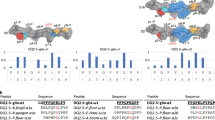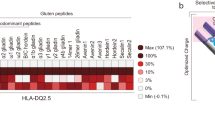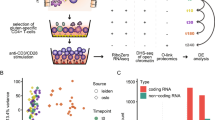Abstract
Celiac disease is a T cell–mediated disease induced by dietary gluten, a component of which is gliadin. 95% of individuals with celiac disease carry the HLA (human leukocyte antigen)-DQ2 locus. Here we determined the T-cell receptor (TCR) usage and fine specificity of patient-derived T-cell clones specific for two epitopes from wheat gliadin, DQ2.5-glia-α1a and DQ2.5-glia-α2. We determined the ternary structures of four distinct biased TCRs specific for those epitopes. All three TCRs specific for DQ2.5-glia-α2 docked centrally above HLA-DQ2, which together with mutagenesis and affinity measurements provided a basis for the biased TCR usage. A non–germline encoded arginine residue within the CDR3β loop acted as the lynchpin within this common docking footprint. Although the TCRs specific for DQ2.5-glia-α1a and DQ2.5-glia-α2 docked similarly, their interactions with the respective gliadin determinants differed markedly, thereby providing a basis for epitope specificity.
This is a preview of subscription content, access via your institution
Access options
Subscribe to this journal
Receive 12 print issues and online access
$189.00 per year
only $15.75 per issue
Buy this article
- Purchase on Springer Link
- Instant access to full article PDF
Prices may be subject to local taxes which are calculated during checkout





Similar content being viewed by others
References
Abadie, V., Sollid, L.M., Barreiro, L.B. & Jabri, B. Integration of genetic and immunological insights into a model of celiac disease pathogenesis. Annu. Rev. Immunol. 29, 493–525 (2011).
Jabri, B. & Sollid, L.M. Tissue-mediated control of immunopathology in coeliac disease. Nat. Rev. Immunol. 9, 858–870 (2009).
Di Sabatino, A. & Corazza, G.R. Coeliac disease. Lancet 373, 1480–1493 (2009).
Sollid, L.M. Coeliac disease: dissecting a complex inflammatory disorder. Nat. Rev. Immunol. 2, 647–655 (2002).
Sollid, L.M. & Jabri, B. Triggers and drivers of autoimmunity: lessons from coeliac disease. Nat. Rev. Immunol. 13, 294–302 (2013).
Petersen, J., Purcell, A. & Rossjohn, J. Post-translationally modified T cell epitopes: immune recognition and immunotherapy. J. Mol. Med. 87, 1045–1051 (2009).
Karell, K. et al. HLA types in celiac disease patients not carrying the DQA1*05–DQB1*02 (DQ2) heterodimer: results from the European Genetics Cluster on Celiac Disease. Hum. Immunol. 64, 469–477 (2003).
Shan, L. et al. Structural basis for gluten intolerance in celiac sprue. Science 297, 2275–2279 (2002).
Henderson, K.N. et al. A structural and immunological basis for the role of human leukocyte antigen DQ8 in celiac disease. Immunity 27, 23–34 (2007).
Kim, C.Y., Quarsten, H., Bergseng, E., Khosla, C. & Sollid, L.M. Structural basis for HLA-DQ2–mediated presentation of gluten epitopes in celiac disease. Proc. Natl. Acad. Sci. USA 101, 4175–4179 (2004).
Molberg, O. et al. Tissue transglutaminase selectively modifies gliadin peptides that are recognized by gut-derived T cells in celiac disease. Nat. Med. 4, 713–717 (1998).
van de Wal, Y. et al. Selective deamidation by tissue transglutaminase strongly enhances gliadin-specific T cell reactivity. J. Immunol. 161, 1585–1588 (1998).
Tollefsen, S. et al. HLA-DQ2 and -DQ8 signatures of gluten T cell epitopes in celiac disease. J. Clin. Invest. 116, 2226–2236 (2006).
van de Wal, Y. et al. Glutenin is involved in the gluten-driven mucosal T cell response. Eur. J. Immunol. 29, 3133–3139 (1999).
van de Wal, Y. et al. Small intestinal T cells of celiac disease patients recognize a natural pepsin fragment of gliadin. Proc. Natl. Acad. Sci. USA 95, 10050–10054 (1998).
Arentz-Hansen, H. et al. The intestinal T cell response to α-gliadin in adult celiac disease is focused on a single deamidated glutamine targeted by tissue transglutaminase. J. Exp. Med. 191, 603–612 (2000).
Arentz-Hansen, H. et al. Celiac lesion T cells recognize epitopes that cluster in regions of gliadins rich in proline residues. Gastroenterology 123, 803–809 (2002).
Qiao, S.W. et al. Tissue transglutaminase-mediated formation and cleavage of histamine-gliadin complexes: biological effects and implications for celiac disease. J. Immunol. 174, 1657–1663 (2005).
Vader, W. et al. The gluten response in children with celiac disease is directed toward multiple gliadin and glutenin peptides. Gastroenterology 122, 1729–1737 (2002).
Anderson, R.P., Degano, P., Godkin, A.J., Jewell, D.P. & Hill, A.V.S. In vivo antigen challenge in celiac disease identifies a single transglutaminase-modified peptide as the dominant A-gliadin T-cell epitope. Nat. Med. 6, 337–342 (2000).
Henderson, K.N. et al. The production and crystallization of the human leukocyte antigen class II molecules HLA-DQ2 and HLA-DQ8 complexed with deamidated gliadin peptides implicated in coeliac disease. Acta Crystallogr. Sect. F Struct. Biol. Cryst. Commun. 63, 1021–1025 (2007).
Vader, L.W. et al. Characterization of cereal toxicity for celiac disease patients based on protein homology in grains. Gastroenterology 125, 1105–1113 (2003).
Vader, W. et al. The HLA-DQ2 gene dose effect in celiac disease is directly related to the magnitude and breadth of gluten-specific T cell responses. Proc. Natl. Acad. Sci. USA 100, 12390–12395 (2003).
Tye-Din, J.A. et al. Comprehensive, quantitative mapping of T cell epitopes in gluten in celiac disease. Sci. Transl. Med. 2, 41ra51 (2010).
Broughton, S.E. et al. Biased T cell receptor usage directed against human leukocyte antigen DQ8-restricted gliadin peptides is associated with celiac disease. Immunity 37, 611–621 (2012).
Qiao, S.W., Christophersen, A., Lundin, K.E. & Sollid, L.M. Biased usage and preferred pairing of α- and β-chains of TCRs specific for an immunodominant gluten epitope in coeliac disease. Int. Immunol. 26, 13–9 (2014).
Qiao, S.W. et al. Posttranslational modification of gluten shapes TCR usage in celiac disease. J. Immunol. 187, 3064–3071 (2011).
Han, A. et al. Dietary gluten triggers concomitant activation of CD4+ and CD8+ αβ T cells and γδ T cells in celiac disease. Proc. Natl. Acad. Sci. USA 110, 13073–13078 (2013).
Turner, S.J., Doherty, P.C., McCluskey, J. & Rossjohn, J. Structural determinants of T-cell receptor bias in immunity. Nat. Rev. Immunol. 6, 883–894 (2006).
Gras, S., Kjer-Nielsen, L., Burrows, S.R., McCluskey, J. & Rossjohn, J. T-cell receptor bias and immunity. Curr. Opin. Immunol. 20, 119–125 (2008).
Godfrey, D.I., Rossjohn, J. & McCluskey, J. The fidelity, occasional promiscuity, and versatility of T cell receptor recognition. Immunity 28, 304–314 (2008).
Yin, Y., Li, Y. & Mariuzza, R.A. Structural basis for self-recognition by autoimmune T-cell receptors. Immunol. Rev. 250, 32–48 (2012).
Bulek, A.M. et al. Structural basis for the killing of human β cells by CD8+ T cells in type 1 diabetes. Nat. Immunol. 13, 283–289 (2012).
Gras, S. et al. A structural voyage toward an understanding of the MHC-I–restricted immune response: lessons learned and much to be learned. Immunol. Rev. 250, 61–81 (2012).
Borg, N.A. et al. The CDR3 regions of an immunodominant T cell receptor dictate the 'energetic landscape' of peptide-MHC recognition. Nat. Immunol. 6, 171–180 (2005).
Bodd, M. et al. Direct cloning and tetramer staining to measure the frequency of intestinal gluten-reactive T cells in celiac disease. Eur. J. Immunol. 43, 2605–2612 (2013).
Yin, Y., Li, Y., Kerzic, M.C., Martin, R. & Mariuzza, R.A. Structure of a TCR with high affinity for self-antigen reveals basis for escape from negative selection. EMBO J. 30, 1137–1148 (2011).
Stadinski, B.D. et al. A role for differential variable gene pairing in creating T cell receptors specific for unique major histocompatibility ligands. Immunity 35, 694–704 (2011).
Turner, S.J. & Rossjohn, J. αβ T cell receptors come out swinging. Immunity 35, 660–662 (2011).
Anderson, R.P. & Jabri, B. Vaccine against autoimmune disease: antigen-specific immunotherapy. Curr. Opin. Immunol. 25, 410–417 (2013).
Sollid, L.M., Qiao, S.W., Anderson, R.P., Gianfrani, C. & Koning, F. Nomenclature and listing of celiac disease relevant gluten T-cell epitopes restricted by HLA-DQ molecules. Immunogenetics 64, 455–460 (2012).
Brochet, X., Lefranc, M.P. & Giudicelli, V. IMGT/V-QUEST: the highly customized and integrated system for IG and TR standardized V-J and V-D-J sequence analysis. Nucleic Acids Res. 36, W503–W508 (2008).
Wang, G.C., Dash, P., McCullers, J.A., Doherty, P.C. & Thomas, P.G. T cell receptor αβ diversity inversely correlates with pathogen-specific antibody levels in human cytomegalovirus infection. Sci. Transl. Med. 4, 128ra42 (2012).
Clements, C.S. et al. The production, purification and crystallisation of a soluble, heterodimeric form of a highly selected T-cell receptor in its unliganded and liganded state. Acta Crystallogr. D Biol. Crystallogr. 58, 2131–2134 (2002).
McPhillips, T.M. et al. Blu-Ice and the Distributed Control System: software for data acquisition and instrument control at macromolecular crystallography beamlines. J. Synchrotron Radiat. 9, 401–406 (2002).
Winn, M.D. et al. Overview of the CCP4 suite and current developments. Acta Crystallogr. D Biol. Crystallogr. 67, 235–242 (2011).
Kabsch, W. Xds. Acta Crystallogr. D Biol. Crystallogr. 66, 125–132 (2010).
Storoni, L.C., McCoy, A.J. & Read, R.J. Likelihood-enhanced fast rotation functions. Acta Crystallogr. D Biol. Crystallogr. 60, 432–438 (2004).
Emsley, P. & Cowtan, K. Coot: model-building tools for molecular graphics. Acta Crystallogr. D Biol. Crystallogr. 60, 2126–2132 (2004).
Adams, P.D. et al. PHENIX: a comprehensive Python-based system for macromolecular structure solution. Acta Crystallogr. D Biol. Crystallogr. 66, 213–221 (2010).
Chen, V.B. et al. MolProbity: all-atom structure validation for macromolecular crystallography. Acta Crystallogr. D Biol. Crystallogr. 66, 12–21 (2010).
Lefranc, M.-P. et al. IMGT, the international ImMunoGeneTics information system(R). Nucleic Acids Res. 33, D593–D597 (2005).
Liu, Y.C. et al. The energetic basis underpinning T-cell receptor recognition of a super-bulged peptide bound to a major histocompatibility complex class I molecule. J. Biol. Chem. 287, 12267–12276 (2012).
Acknowledgements
We thank the staff of the Monash crystallization facility and the Australian Synchrotron for assistance with crystallization and data collection, respectively. This work was supported by the Australian Research Council, the National Health and Medical Research Council (NHMRC) of Australia, the Celiac Disease Consortium and an Innovative Cluster approved by The Netherlands Genomics Initiative and was funded in part by the Dutch government (grant BSIK03009). We thank J. Tye-Din for assistance. J.R. is supported by an Australia Fellowship from the NHMRC.
Author information
Authors and Affiliations
Contributions
J.P. and V.M. are joint first authors. J.R.M., K.L.L., D.X.B., M.v.L., A.T., M.L.M., J.S., Y.K.-W., J.v.B., J.W.D., W.-T.K., N.L.L.G. and R.P.A. performed experiments, provided key reagents and/or analyzed data and/or provided intellectual input or helped write the manuscript. H.H.R., F.K. and J.R. are joint senior and corresponding authors, co-led the investigation and contributed to the design and interpretation of data, project management and writing of the manuscript.
Ethics declarations
Competing interests
R.P.A. is a co-inventor of patents pertaining to the use gluten peptides in therapeutics, diagnostics and nontoxic gluten. R.P.A. is a shareholder and Chief Scientific Officer of ImmusanT Inc., a company developing a peptide-based therapy and diagnostic suitable for celiac disease.
Integrated supplementary information
Supplementary Figure 1 Unbiased electron density maps of the peptides.
Simulated annealing omit electron density maps (2Fo-Fc) for the peptide in a) S2-HLA-DQ2.5-glia-α1a, b) S16-HLA-DQ2.5-glia-α2, c) D2-HLA-DQ2.5-glia-α2, d) JR5.1-HLA-DQ2.5-glia-α2
Supplementary Figure 2 Affinity measurements of D2 TCR mutants binding to HLA-DQ2.5-glia-α2.
Surface plasmon resonance analysis of D2 TCR mutants interacting with HLA-DQ2.5-glia-α2. a) Concentration series of each TCR were passed over surface immobilized HLA-DQ2.5-glia-α2. For KD determination all data from (n=) replicate experiments was combined for each mutant, and the single ligand binding model was used for curve fitting. The maximal calculated response (not shown) for each concentration series was used for data normalization (normalized response +/− SD). b) Comparison of KD values for binding to HLA-DQ2.5-glia-α2 of the D2 TCR and of the D2 TCR mutants. The dashed and dotted lines represent the cut off for a significant (5-fold) increase and a moderate (3-fold) increase in KD over the value determined for the D2 TCR wildtype (15.8 μM). Significant, moderate or no increase of KD values is represented by striped, grey and empty bars, respectively.
Supplementary information
Supplementary Text and Figures
Supplementary Figures 1–2 and Supplementary Tables 1–4 (PDF 7684 kb)
Rights and permissions
About this article
Cite this article
Petersen, J., Montserrat, V., Mujico, J. et al. T-cell receptor recognition of HLA-DQ2–gliadin complexes associated with celiac disease. Nat Struct Mol Biol 21, 480–488 (2014). https://doi.org/10.1038/nsmb.2817
Received:
Accepted:
Published:
Issue Date:
DOI: https://doi.org/10.1038/nsmb.2817
This article is cited by
-
Characterizations of a neutralizing antibody broadly reactive to multiple gluten peptide:HLA-DQ2.5 complexes in the context of celiac disease
Nature Communications (2023)
-
Single cell transcriptomic analysis of the immune cell compartment in the human small intestine and in Celiac disease
Nature Communications (2022)
-
T cell receptor recognition of hybrid insulin peptides bound to HLA-DQ8
Nature Communications (2021)
-
Potential impact of celiac disease genetic risk factors on T cell receptor signaling in gluten-specific CD4+ T cells
Scientific Reports (2021)
-
T cell receptor cross-reactivity between gliadin and bacterial peptides in celiac disease
Nature Structural & Molecular Biology (2020)



